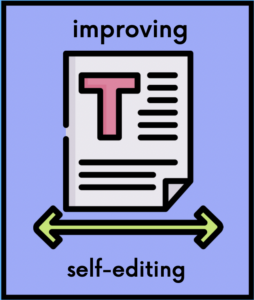
Self-Editing Overview
“We want them to leave our classrooms able to function as competent self-editors, able to
continue their growth as writers as they incorporate new strategies into their practice. We
envision for them lifelong success extending their abilities to communicate meaningfully with
the written word without tripping unacceptably over mechanical conventions.” (“Independent
Repatterning: Developing Self-Editing Competence” by Kathleen D. Andrasick, p. 28)
Introduction
At times, the idea of teaching self-editing may feel counter to our instructional role and student
expectations. One of the ways we perform the labor of instruction is through our correction of
student papers, and if we do not express ourselves through marginal notes, we feel as though
we are neglecting our students. Worse, our students may feel that we neglecting them.
However, most of us learn to recognize that marking one more missing comma is not going to
help our students to use them correctly, and it is less helpful to teach our students that “and” is
a coordinating conjunction than to teach them how to use it in a sentence. Teaching our
students to edit their own work is a worthy endeavor that extends beyond the current
semester, and the extra time offered within an ENA101 course allows for at least the possibility
of that transfer of responsibility from instructor to student, which is ultimately more helpful for
the student throughout their college career and beyond.
Improving Self-Editing (from LaGuardia’s ENA framework statement; emphasis mine)
Previously, we expressed our view that ENA 101 should not feel like a grammar class to the
students. We do not recommend that students arriving in these courses face weeks of exercises
in identifying parts of speech and choosing the correct forms of verbs. This does not, however,
mean that we do not recognize an obligation to help students become more effective at editing
their writing to reduce the frequency and severity of sentence-level errors. The goal of any
form of “grammar” instruction is to help our students become, not grammarians, but more
effective editors of their writing. In most cases, this means a de-emphasis on learning
grammatical terms and concepts and increased emphasis on effective communication and
editing their own writing.
We believe, as educators, that whatever grammar we teach will only be effective if it is applied
to the students’ own writing: “practice editing” what they have written is a more productive
use of class time than doing grammar worksheets.
General Principles
- Taking a less-involved approach to encourage students to edit their own work
- Promoting other sources of outside input on writing (peer review, technology)
- Some key words and phrases: self-editing, professional/proficient (not perfect), read work aloud, re- (revisit, reexamine, revise, repatterning), big to small, focus on audience
Resources
For Background Information
- “Independent Repatterning: Developing Self-Editing Competence” by Kathleen D. Andrasick
- “Inculcating Self-editing Skills for Enhancing Writing Skills of the EFL Students” by Valentina Sangeetha
- “Peer Review via Three Modes in an EFL Writing Course” by Ching-Fen Chang
- “The Triple Flip: Using Technology for Peer and Self-Editing of Writing” by Zeina Hojejj
For Classroom Use
- “Customize Your Self-Editing Approach” by Sage Cohen (2 pages)
- “Revision & Self-Editing: 7 Steps to a Foolproof Revision” by Don Fry (4 pages)



Leave a Reply